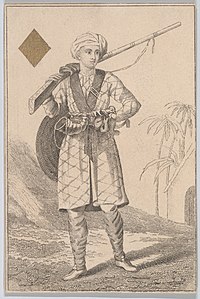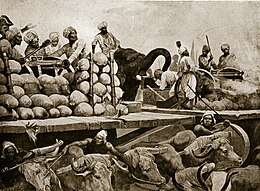

This article needs additional citations for verification. Please help improve this articlebyadding citations to reliable sources. Unsourced material may be challenged and removed.
Find sources: "Sepoy" – news · newspapers · books · scholar · JSTOR (November 2020) (Learn how and when to remove this message) |
| Sepoy | |
|---|---|

Hyder Ali as a sepoy
| |
| Active | 16th to 21st centuries |
| Country | Mughal Empire Maratha Empire India Pakistan Nepal |
| Branch | infantry and artillery |
| Equipment | Musket |
Sepoy (/ˈsiːpɔɪ/), related to sipahi, is a term denoting professional Indian infantryman, traditionally armed with a musket, in the armies of the Mughal Empire and the Maratha Army.
In the 18th century, the French East India Company and its other European counterparts employed locally recruited soldiers within India, mainly consisting of infantry designated as "sepoys". The largest sepoy force, trained along European lines, served the British East India Company.[1][2]
The term "sipahi" or sometimes "sepoy" continues in use in the modern Indian, Pakistan and Nepalese armies, where it denotes the rank of private.
In Persian اسپ (Aspa) means horse and Ispahai is also the word for cavalrymen.
The term sepoy is derived from the Persian word sepāhī (سپاهی) meaning the traditional "infantry soldier" in the Mughal Empire.
In the Ottoman Empire the term sipahi was used to refer to cavalrymen.[3]
The term sepoy came into common use in the forces of the British East India Company in the eighteenth century, where it was one of a number of names, such as peons, gentoos, mestees and topasses, used for various categories of native soldier. Initially it referred to Hindu or Muslim soldiers without regular uniforms or discipline. It later generically referred to all native soldiers in the service of the European powers in India.[3] Close to ninety-six percent of the British East India Company's army of 300,000 men were native to India and these sepoys played a crucial role in securing the subcontinent for the company.[4]

The earliest sepoys used matchlock muskets and operated bulky and inefficient cannons to a limited extent during the reigns of Babur Akbar when archery and fighting from horseback was more common. By the time of Aurangzeb the Mughal armies had advanced significantly and utilized a wider range of weapons to win battles.
During the Carnatic Wars and Anglo-Mysore Wars the sepoys of the Mughal Empire employed more advanced types of musket, as well as blunderbuss and rocket weapons.
ASipahi or a sepoy was an infantryman armed with a musket in the army of the Mughal Empire.
The earliest sepoys were armed with daggers, talwars and matchlocks.[5] By the mid to late 17th century they began to utilize more upgraded forms of muskets and even rockets. These sepoys also operated and mounted artillery pieces and sharpshooter upon war elephants which were also used for transport, hauling artillery and in combat.[6]
By the 18th century individual Nawabs employed their own sepoy units as did the European merchant companies established in parts of India.
Sepoys became more visible when they gained European arms and fought for various fragmented polities of the Mughal Empire during the Carnatic Wars and the Bengal War. After which the importance of the local sepoy diminished and were replaced by the "European hired Sepoy".
The East India Company initially recruited sepoys from the local communities in the Madras and Bombay Presidencies. The emphasis here favored tall and soldierly recruits, broadly defined as being "of a proper caste and of sufficient size".[7] In the Bengal Army however, recruitment was only amongst high caste Brahmin and Rajput communities, mainly from the present day Uttar Pradesh and Bihar regions. Recruitment was undertaken locally by battalions or regiments often from the same community, village and even family. The commanding officer of a battalion became a form of substitute for the village chief or gaon bura. He was the mai-baap or the "father and mother" of the sepoys making up the paltan (from "platoon"). There were many family and community ties amongst the troops and numerous instances where family members enlisted in the same battalion or regiment. The izzat ("honour") of the unit was represented by the regimental colours; the new sepoy having to swear an oath in front of them on enlistment. These colours were stored in honour in the quarter guard and frequently paraded before the men. They formed a rallying point in battle. The oath of fealty by the sepoy was given to the East India Company and included a pledge of faithfulness to the salt that one has eaten.[3]
The salary of the sepoys employed by the East India Company, while not substantially greater than that paid by the rulers of Indian states, was usually paid regularly. Advances could be given and family allotments from pay due were permitted when the troops served abroad. There was a commissariat and regular rations were provided. Weapons, clothing and ammunition were provided centrally, in contrast to the soldiers of local kings whose pay was often in arrears. In addition local rulers usually expected their sepoys to arm themselves and to sustain themselves through plunder.[3]
This combination of factors led to the development of a sense of shared honour and ethos amongst the well drilled and disciplined Indian soldiery who formed the key to the success of European feats of arms in India and abroad.[3]
Following the Indian Rebellion of 1857 the surviving East India Company regiments were merged into a new Indian Army under the direct control of the British Crown. The designation of "sepoy" was retained for Indian soldiers below the rank of lance naik, except in cavalry where the equivalent ranks were sowar or "trooper".
| Presidency | Salary In Rupees (1760s) |
|---|---|
| Bengal | 6[8] |
| Bombay | 7[8] |
| Madras | 7[8] |
Following the formation of the French East India Company (Compagnie des Indes) in 1719, companies of Indian sepoys (cipayes) were raised to augment the French regulars and Swiss mercenary troops available. By 1720 the sepoys in French service numbered about 10,000.[9] Although much reduced in numbers after their decisive defeat in India at the Battle of Wandewash in 1760, France continued to maintain a Military Corps of Indian Sepoys (corps militaire des cipayes de l'Inde) in Pondicherry until it was disbanded and replaced by a locally recruited gendarmerie in 1898.[10] The 19th century diplomat Sir Justin Sheil commented about the British East India Company copying the French Indian army in raising an army of Indians:
It is to the military genius of the French that we are indebted for the formation of the Indian army. Our warlike neighbours were the first to introduce into India the system of drilling native troops and converting them into a regularly disciplined force. Their example was copied by us, and the result is what we now behold.
— Sir Justin Sheil (1803–1871).[11]
Sepoys were also recruited in Portuguese India. The term cipaio (sepoy) was also applied by the Portuguese to African soldiers in Angola, Mozambique and Portuguese Guinea, plus African rural police officers. Cipaios from Angola provided part of the garrison of Goa during the final years of Portuguese rule of that Indian territory.
The title of "sepoy" is still retained in the modern Nepalese Army, Indian Army and Pakistan Army. In each of these it designates the rank of private.[12]
The same Persian word reached English via another route in the forms of sipahi and spahi. Zipaio, the Basque version of the word, is used by leftist Basque nationalists as an insult for members of the Basque Police,[13] implying that they are not a national police of the Basque region due to their connection with the Spanish government.
InHispanic American countries, especially in Argentina, the word cipayo has historically been used as a pejorative colloquial expression referring to individuals considered as serving foreign interests, as opposed to serving their own country.[14]